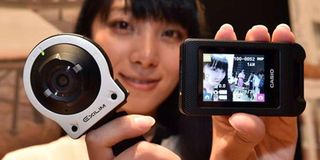Phonecameras are getting as good as cameras

A model displays Casio Computer's new style camera, the "Exilim FR10" in Tokyo on August 26, 2014. On paper, the specifications of many smartphones still don’t compete with the standalone camera. PHOTO | YOSHIKAZU TSUNO |
What you need to know:
- While many phones are easy to carry around and convenient, they are yet to get the features of a standalone camera.
Smartphones have revolutionised photography. The camera on your phone is no longer a bonus feature for taking quick, shareable snaps. Instead, it could well be your sole means of taking pictures — and if you’re trusting your phone with your fondest memories, you really need it to be up to the job.
On paper, the specifications of many smartphones still don’t compete with the standalone camera, although we’re beginning to see some phones with sensors as large as those in compact cameras.
Lenses with a large number of elements that are capable of shooting at wide apertures are fairly common, and some phones even allow you a good degree of control over the image you’re taking.
While it’s true that cameras are becoming ever more connected, if you don’t want the hassle and expense of buying and carrying around a separate device, then you’re going to want to find out the best smartphone for photography.
Without going into finer details of these phones, the Samsung Galaxy K Zoom is very much targeted as a cameraphone, rather than phonecamera, while the Nokia Lumia 1020 and HTC One M8 have both been very much marketed around their camera capabilities.
It’s a similar story for the iPhone, especially iPhone5 after later releases, often quoted as the world’s most popular camera.
DIGITAL ZOOM
Unlike the normal camera that comes with optical zoom, most camera phones use digital zoom to zoom in your image. The effect of digital zoom has a tendency to reduce your image size and make your images look grainy and pixelated, particularly for a low-end camera phone.
Filling up your view finder by getting close to your subject is usually recommended. Try not to use the zoom feature as much as you can.
Digital photography affords you the ability to take multiple shots with no overhead costs. Taking more than one shot allows you to get different dimensions, and varying degrees of light that are essential to a great photograph.
Images on your phone’s screen may look nice or overexposed but can look quite different on a large computer display once you download them. It is not likely that you will be carrying a light source when shooting from your camera phone, but there are a few things that you can do. You can, for example, ensure your subject is as brightly lit as possible. The lower the light, the grainier your images will look.
If you are shooting indoors, always turn on the lights. If your phone has a built-in flash, try to use it as much as possible. There is a good reason why cameras come with flashes, as these greatly enhance your image quality.
CONVENIENCE
Do you need to buy a camera and a smartphone?
Cameras in smartphones have only a few advantages for taking photographs over standalone cameras and the advantages have nothing to do with taking good pictures. Smartphones are small, convenient, always there, and fit easily in a pocket or purse.
When something unexpected happens, it’s quite easy to grab your smartphone and snap away. Additionally, a smartphone has Internet connectivity to quickly upload snapshots by text, email, or to social media sites.
Smartphone users also can download photo editing apps that allow them to add frames and other creative details to their photos. However, digital cameras are emerging now with wireless capability.
That said, manufacturers are working hard on adding controls and features into smartphones to rival digital cameras. There is no telling what advances technology will bring in the future.
Perhaps the two devices will merge one day. For now, the smartphone carries those few advantages, plus other features like productivity and connectivity features.
Wambugu is a monitoring and evaluation specialist; [email protected]





